This 30-minute Japanese miso eggplant recipe is perfect for a quick night meal. It's also easy to make and for sure is a delicious Japanese dish that the whole family will enjoy. The eggplant is nicely caramelized and has such creamy, velvety texture that will melt in your mouth.
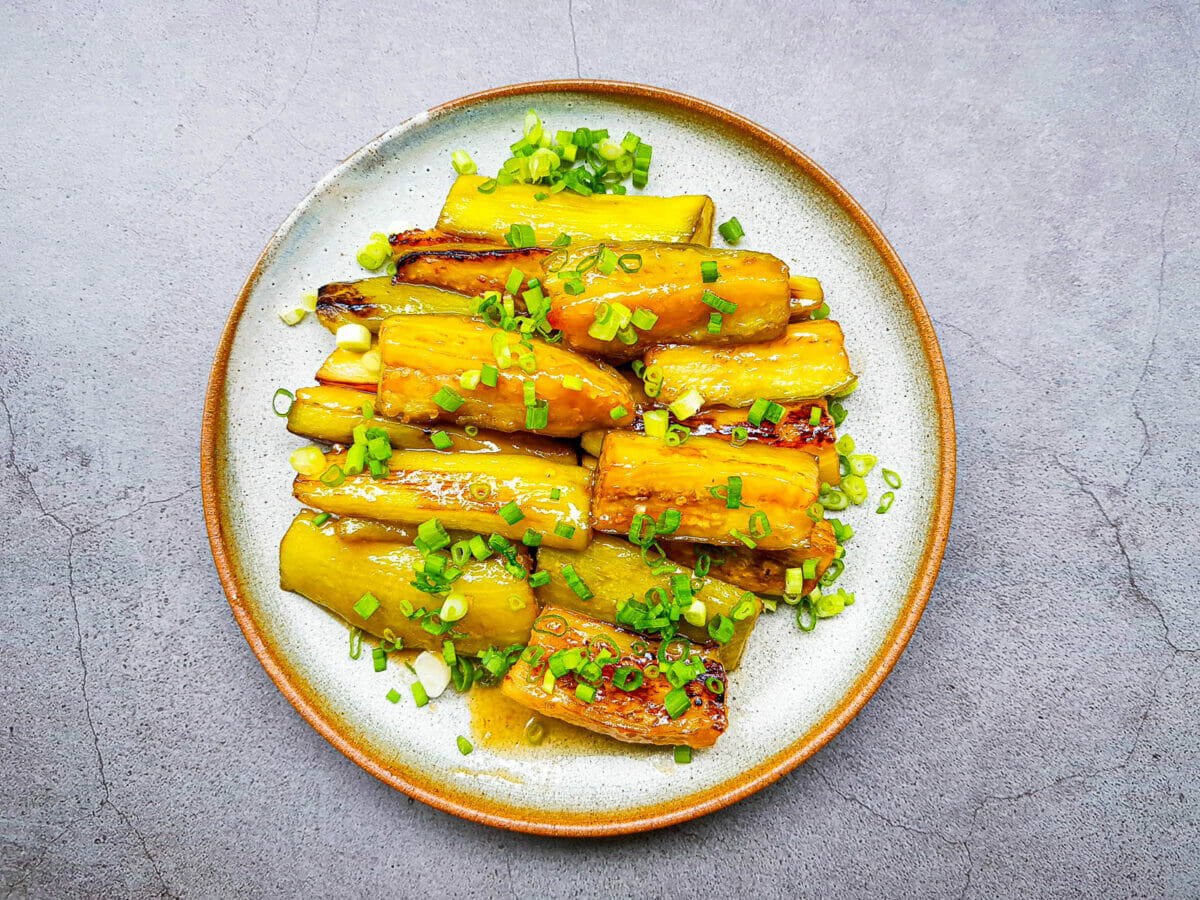
This Japanese miso eggplant is so wonderfully flavorful and juicy. It simply a must-try at your dinner table. Not to mention this eggplant recipe is vegan and gluten free which is an advantage for any folks that are on special diet.
Want more delicious eggplant recipes? I still have this Vietnamese style eggplant served with scallion oil. A good new is it's also vegan and gluten free. Also, be sure to check out my vegetarian collections for more special diet recipes.
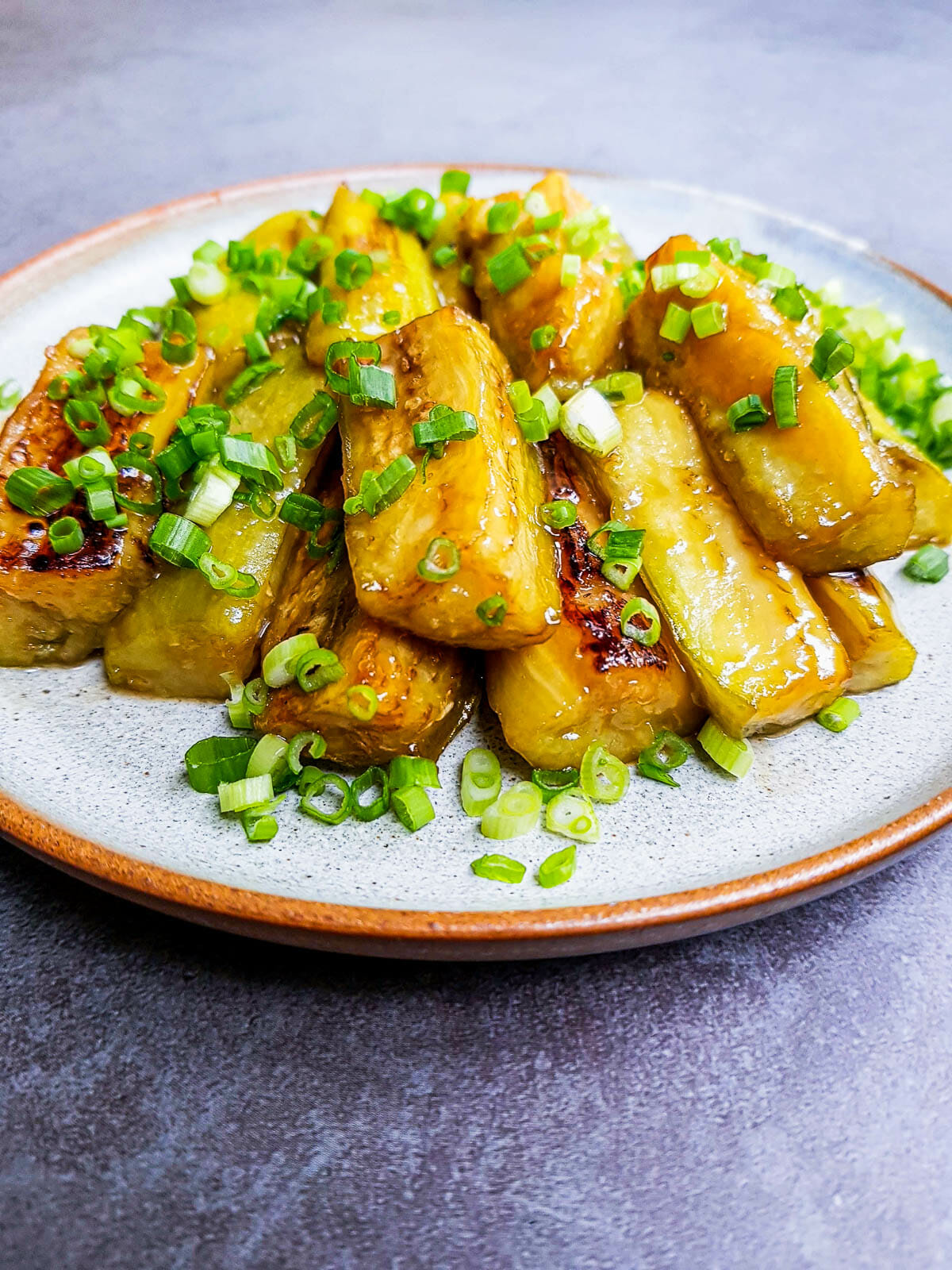
Why this 30-minute Japanese miso eggplant is the best!
- Quick and easy: the name says it all. This recipe takes only 15 minutes to prep and 15 minutes to make.
- Creamy and melt in your mouth: this delicious eggplant dish is not only tasty but also very tender, velvety. It's a dream dish for any eggplant lover.
- Vegan and gluten free: if you're on special diet and want to look for an awesome dish? Look no further. This Japanese eggplant recipe is all you need.
- Beautiful looking dish: with the right garnishes, this homemade eggplant dish can easily transform into an elegant fine dining style dish. So you can definitely serve this simply irresistible eggplant plate for any special occasion.
What is miso?
Miso is a popular ingredient used in Japanese cuisine. It is a thick paste made by salting and fermenting soybeans and rice/barley. Because miso is a soybean-based ingredient, it remains one of the most contemporary choices for vegetarian/vegan cooking.
Miso can be used in both cold and warm cooking methods. However it should never be boiled because high cooking temperature can kill beneficial enzymes and bacteria in miso.
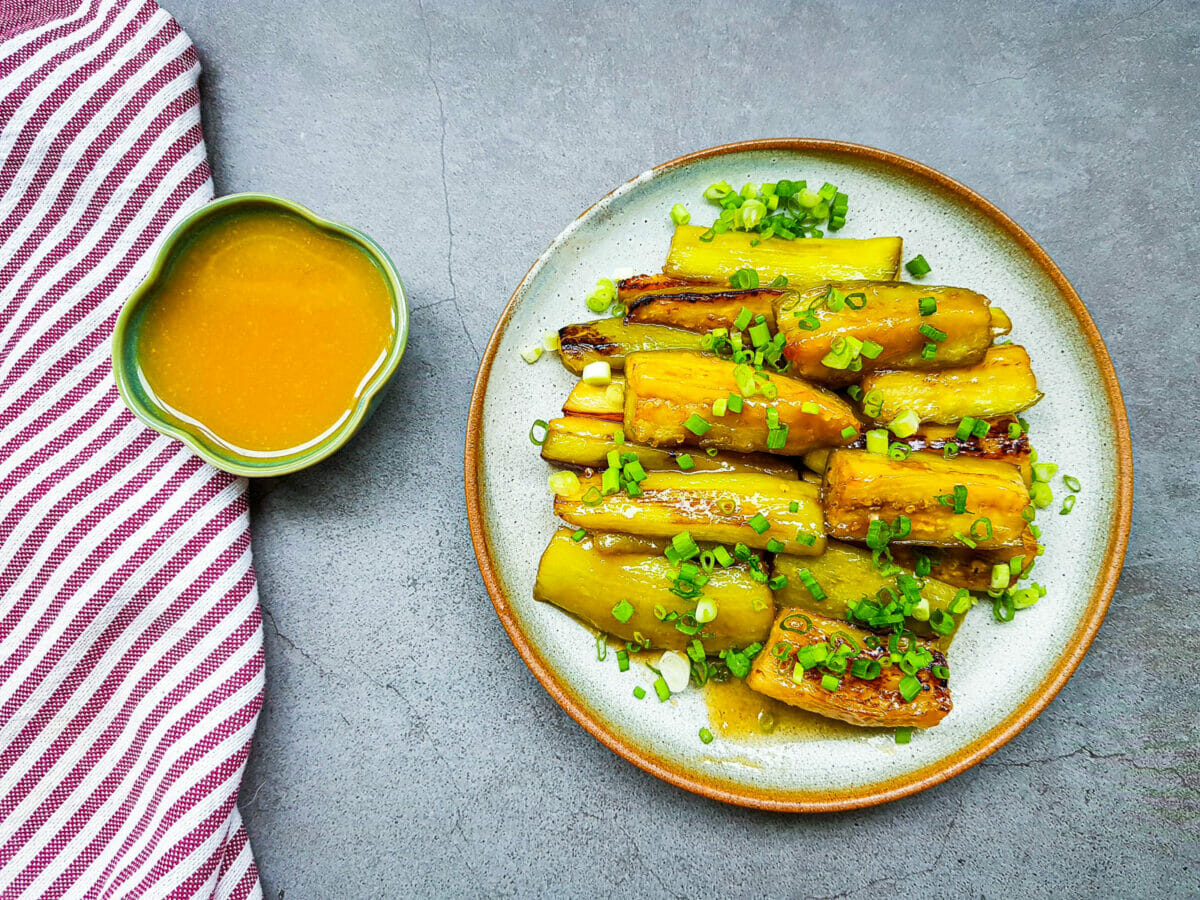
Types of miso
Miso is an essential ingredient in Japanese cuisine and there are three basic miso varieties:
- Mamemiso: miso made just from soybeans
- Mugimiso: miso made from barley and soybeans
- Komemiso: miso made from rice and soybeans
Compared to its sister version, komemiso is more popular and widely used out of Japan, especially in the States. The two forms of komemiso that are usually found are: white miso (shiro miso) and red miso.
- Red miso contains higher percentage of soybeans, and is fermented longer than white miso. That makes it have stronger and saltier flavor.
- White miso is creamy and contains a high percentage of rice. It has a mild and sweet flavor. I use white miso in this quick delicious Japanese dish.
Where to buy miso?
Most of these varieties of miso can be found at Asian markets and sometimes even health store. But if you have a hard time looking for it, well you know Amazon literally has everything including this organic white (shiro) miso that I'm using in this 30-minute Japanese miso eggplant recipe.
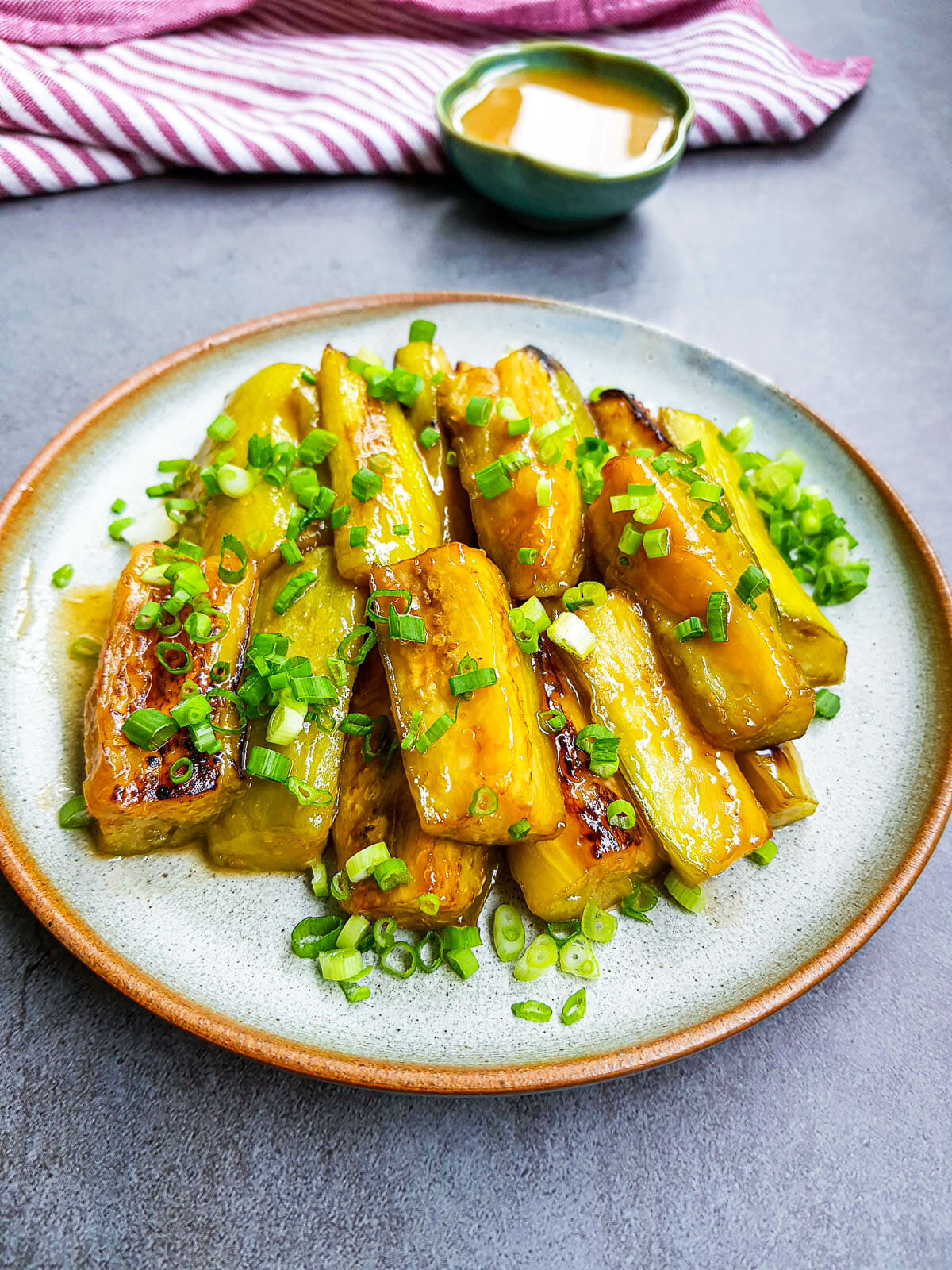
Types of eggplant
There are two types of eggplant that commonly see in grocery store: Asian and western ones.
Asian eggplants are either round or long and thin. Their skin colors ranging from light purple to deep purple, sometimes cloudy white. Western eggplants are more popular in the States and have a giant pear shape. They have a very shiny skin with color ranging from deep purple to purple-black.
Asian eggplants are softer than their western cousins. The good news is you can use either types of eggplant for this recipe.
Ingredients for Japanese miso eggplant recipe
Besides white miso and eggplant, there few other essential ingredients that require in this recipe:
- Mirin: a fortified wine made from glutinous rice and used solely for cooking purposes. Mirin is available in most Asian market or well, on Amazon.
- Sugar: white granulated sugar works fine in this recipe.
- Green onion: for garnish.
- Nori: this is used as garnish and optional. Nori is also vegan friendly.
- Toasted sesame seeds: optional, used for garnish. White sesame seeds work better due to its brighten color.
- Bonito flakes: this is optional. Thus bonito flakes are made from fish, so if you use this as garnish, please keep in mind it won't be a vegan recipe anymore.
What to serve this miso eggplant with
This miso eggplant is best to serve hot or at least warm. Don't let it sit at room temperature for too long as it'll become soggy and stale overtime.
This tasty sweet miso eggplant dish can be served with this breaded chicken cutlets (which is also gluten free), soy sauce chicken thighs, Sriracha charsiu chicken or sweet chili salmon.
FAQs
As mentioned above, miso is made by salting and fermenting soybeans with rice or barleys. So with its high salt content, miso paste can be kept indefinitely under refrigeration. If you open the original package, be sure to keep the rest in an air tight container or zip loc.
The miso sauce in this miso eggplant recipe can be kept in an air tight container, under refrigeration for up to 2 months.
Definitely. You can make miso sauce and fry eggplant in advance. Then keep both in an air tight container. As for fried eggplant, it's better to have a layer of oil-absorbed paper towel inside the container to prevent them becoming soggy. Then when you're ready to serve, just take both of them out of the fridge and proceed with stir-frying step in the recipe.
Did you make this recipe? If so please leave a rating and let me know how it went in the comment section. Also, don't forget to tag me #cookmorphosis @cookmorphosis on social media.
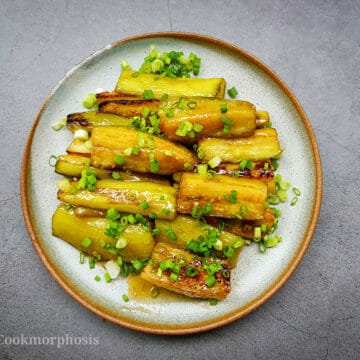
30-Minute Japanese Miso Eggplant
Equipment
- Rimmed baking pan lined with oil absorbed paper
Ingredients
- 2 Asian eggplants peeled, cut into 2x5 sticks
- 2 sprig green onion chopped, for garnish
- 2-3 c vegetable oil for frying
Miso sauce
- 5 oz white miso (shiro miso) paste
- 2 oz sugar
- 1.5 c mirin or 1 c of sugar for substitution
- 1 c water
Instructions
Making miso sauce
- In a small sauce pan, combine all ingredients on medium heat and bring to simmering point. Let the mixture simmer for 10-15 minutes or until it reduced by half.5 oz white miso (shiro miso) paste, 2 oz sugar, 1.5 c mirin, 1 c water
- Turn off the heat. The mixture still has a liquidy-texture. Set aside for later use.
Frying eggplant
- Fill a big pot with vegetable oil for frying. Bring oil to 350F-375F.2-3 c vegetable oil
- Work in small batch and quickly blanch eggplants in hot oil. Each batch should be around 3-4 minutes. Eggplants should have a very light golden bright color. Don't let them turn too dark.2 Asian eggplants
- Take fried eggplant out and lay on rimmed baking pan already lined with oil absorbed paper.
Stir-frying miso eggplants
- In a medium sauteed pan, add already-fried eggplants (about 6-7 sticks) and cook on medium heat. If the heat is set too high, when miso sauce is added, it will be burned very quickly.
- Carefully stir eggplants then add enough miso sauce to coat the eggplant thoroughly (about2 tbsp).
- Take off the heat and serve immediately, garnish with green onions. Enjoy!2 sprig green onion
Notes
Optional garnishes:
- Nori: this is used as garnish and optional. Nori is also vegan friendly.
- Toasted sesame seeds: optional, used for garnish. White sesame seeds work better due to its brighten color.
- Bonito flakes: this is optional. Thus bonito flakes are made from fish, so if you use this as garnish, please keep in mind it won't be a vegan recipe anymore.

I have yet to make this, but before I forget and lose the page or some other catastrophy, I just wanted to thank you for putting the ingredients in with the cooking steps. I so very much appreciate having everything in one place instead of switching screens. thank you!
Hi Patti,
I try my best to accommodate my readers. Please let me know how you like it (or not) afterwards.
Hi what kind of measurement is a c ? e.g. 1 to 1 and a half c of miren.
Hi Kelly,
Sorry for the confusion. C means cup in the recipe. :).
I hadn’t made anything like this dish before but it was a huge hit! The sauce is incredible and there was a ton left over so will be using it for a while. We also added some garlic to the sauce before sautéing!
Hi Dana,
I'm so happy that you love the sauce. Yeah, it is one heck of a sauce, you can use it for other veggies too if you want.